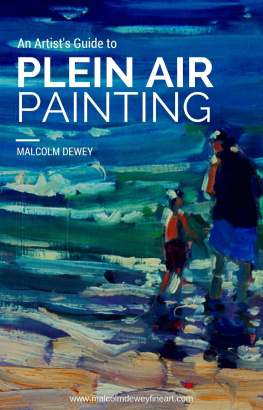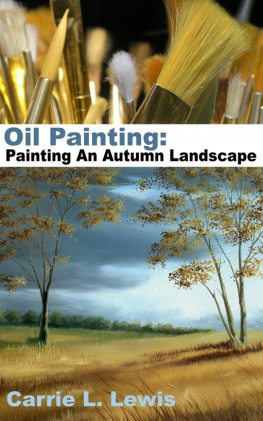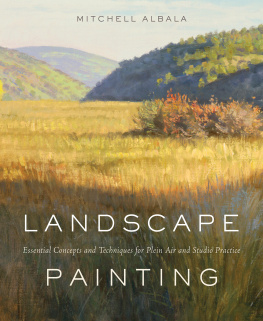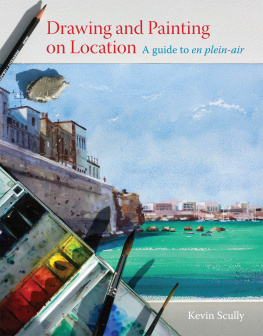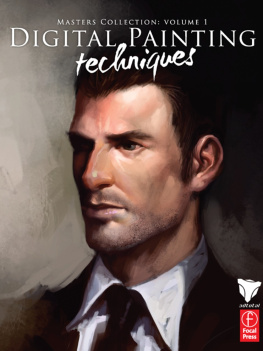What is plein air painting?
P lein air painting means painting outdoors - in the open air to be precise. Outdoor painting developed from the impressionist movement from the mid-19th century. Innovations like the paint tube in the 1840s made it possible to take paint outside the studio. Added to this innovation was the impressionist movement that exploited these innovations.
Portable easels and palettes made outdoor painting possible without too much trouble too.
The fame of pioneers like John Constable proved that real life scenes had appeal to the new class of art admirer. It was not long before outdoor painting became fashionable. Although Constable was not an impressionist he did paint the famous Hay Wain . This painting depicted a romantic view of an everyday farm community at work. A romantic notion that admired by the new urban class.

Figure 1: The Haywain by John Constable
The impressionists aimed to paint real life scenes and the natural light effects supplied by mother nature. This concern with natural light became a passion in itself. Famous artists like Monet dedicated their careers to this pursuit.
Art became more democratised and a popular activity for the merchant and professional classes. Social painting outdoors was not uncommon.
Fast forward to the present and we can see plein air painting taking off in ever greater popularity. The reasons for this are many and include relaxation from the pressures of work. There is also a pleasant break from our digital world back to the analog world of paints and brushes.
Organised paint outs are popular in larger centres adding to the social aspect of art. A growing industry in painter's equipment has resulted in all manner of kit to make outdoor painting easier. Add to this the exposure to the great outdoors and we have a perfect leisure industry for those with time on their hands.
Professionals and serious part-timers see the benefits from painting in the landscape itself. The immediacy and experience provides a holistic painting experience often lost in the studio.
What exactly does painting outdoors entail?
T his is a matter of debate. Some suggest a certain percentage of the painting must have completed outdoors to qualify as plein air. What that percentage is can vary between 50 to 70 percent. Others want the entire painting done outdoors.
We can find guidance from the impressionist themselves. They did not impose limits, but even then there does seem to be some controversy. Monet did argue that his outdoors paintings were not completed in the studio. It seems clear that many were completed indoors.
The preferable approach is:
- that the subject must be outdoors.
- Research and prepare the painting onsite.
- The painting must have progressed at least halfway to completion outdoors.
How difficult is it to meet these criteria? Weather permitting there should be no real trouble for the average artist to complete a painting outdoors. The painting size of 20cm x 25cm is small enough to make completion possible. A certain touch-up or two in the studio might be necessary, but that's about it. As with all things a bit of preparation makes this experience a pleasurable one.
Getting started:
W hat are your objectives?
Having an idea about what you want to achieve goes a long way to helping you on the correct path. For example if you want to produce several finished works to sell then you need to have your preparation in good shape. If you are looking for a few quick preparatory studies that may go on to become studio works then you will need only a basic kit. All these approaches are valid as they fall within the concept of painting from a real and authentic subject.
This guide is for someone looking to paint outdoors for pleasure. You would also like to complete at least one painting with a few sketches and studies for later work in the studio. Learn more about the benefits of plein air painting on my plein air page. http://bit.ly/1NRCt9w
What are the benefits of plein air painting?
I s it worth the trouble?
Besides the pleasure elements suggested above there are significant benefits for the artist.
Notes from the field become part of an ongoing experience where each painting contributes in some way to the next. (Gavin Brooks)
- Colors outdoors are different when photographed. Personal observation trains the artist's eye to take note of accurate colors.
- Picking out composition when facing the vast panorama is daunting at first. The artist quickly learns techniques to isolate strong compositions.
- Selection of elements necessary for composition and disregarding others will develop the artist's eye.
- The ability to observe shadow areas filled with life rather than underexposed darks in photos is an added benefit.
- You will learn how to simplify a scene.
- Identify shapes and values better.
- Learn to mix colors from a limited palette of colors.
- You will learn all these skills under the pressure of time and the changing weather that this implies.
Basic Equipment
E ssentials include:
- Paint: a smaller palette makes outdoors work more intuitive than fiddling with many tube colors. Try titanium white, cad red light, cad yellow light and ultramarine blue. Add to this alizarin and pthalo green. If you prefer the luxury of more colors then burnt sienna may make your life easier. There is no need for more than this.
- Brushes: a selection of size 6-8 of flats and filberts will do the trick. Keep your painting surface to approximately 20cm x 25cm. Bigger surfaces? Then a size 10 or 12 will be handy for laying in larger shapes. Bristle or finer hair is all good. Add a rigger for a few details like branches, telephone wires and such. It is also useful to draw your initial shapes if you are so inclined.
- Add a palette knife that is flexible enough to paint with too.
Mediums:
- To save space I am happy to have basic odorless white spirits. Get best quality - it does make all the difference. You may wish to add a little premixed medium like linseed oil mixed with spirits to aid with initial lay in of colors with thin layers. A ratio of fifty/fifty will be suitable. Also a medium to speed drying such a Liquin may be helpful. You can get by with just the white spirits.
Containers:
- These make life outdoors so much easier. A few plastic containers that have reliable screw on lids will help to hold the white spirits. A second container for any other medium will do. A plastic bag for trash is necessary. A plastic brush container will keep your brushes out of harm during transportation. No bent bristles please!

